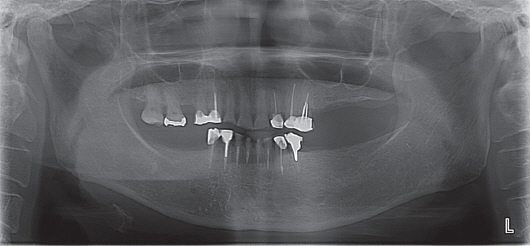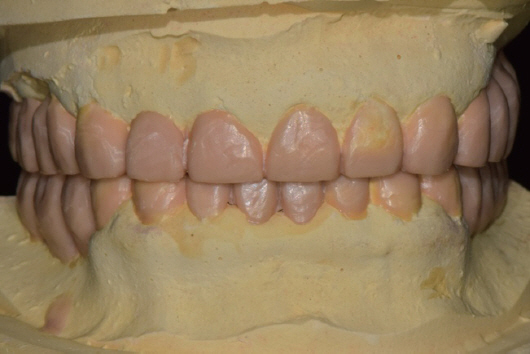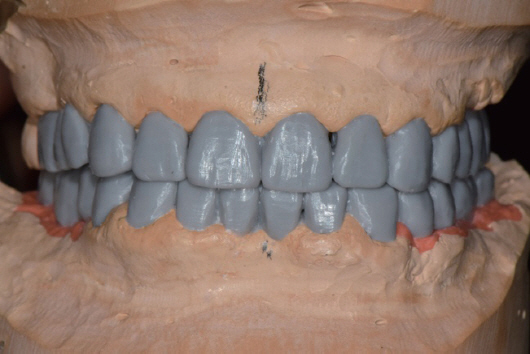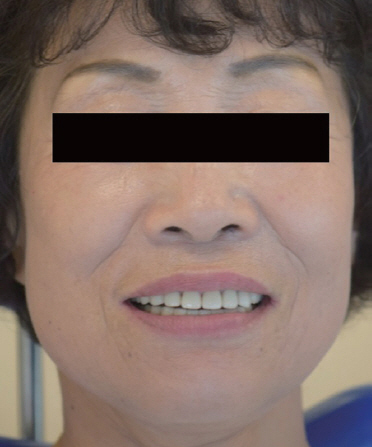J Dent Rehabil Appl Sci.
2016 Sep;32(3):255-262. 10.14368/jdras.2016.32.3.255.
Full mouth rehabilitation of severely worn dentition using posterior implants: a clinical report
- Affiliations
-
- 1Department of Prosthodontics, Seoul St. Mary's Dental Hospital, The Catholic University of Korea, Seoul, Republic of Korea. lsuyoung@daum.net
- KMID: 2357855
- DOI: http://doi.org/10.14368/jdras.2016.32.3.255
Abstract
- This clinical report focuses on the treatment of a patient with esthetic and functional impairments due to severe worn dentition. Absence of posterior support for a prolonged period require comprehensive prosthetic restoration. Accurate clinical and radiographic examinations, diagnostic wax-up, and occlusal vertical dimension evaluation were performed and the degree of patient adaptability was evaluated using an interim restoration. After 8 weeks of stabilization with interim restoration and confirmation of absence of any abnormal findings, definitive prostheses were fabricated. Satisfactory functional and esthetic outcomes were observed after 6 months of follow-up.
MeSH Terms
Figure
Reference
-
References
1. Grippo JO, Simring M, Schreiner S. Attrition, abrasion, corrosion and abfraction revisited: a new perspective on tooth surface lesions. J Am Dent Assoc. 2004; 135:1109–18. quiz 1163-5. DOI: 10.14219/jada.archive.2004.0369. PMID: 15387049.2. Verrett RG. Analyzing the etiology of an extremely worn dentition. J Prosthodont. 2001; 10:224–33. DOI: 10.1053/jpro.2001.28264. PMID: 11781971.3. Crothers AJ. Tooth wear and facial morphology. J Dent. 1992; 20:333–41. DOI: 10.1016/0300-5712(92)90019-9.4. Smith BG, Knight JK. A comparison of patterns of tooth wear with aetiological factors. Br Dent J. 1984; 157:16–9. DOI: 10.1038/sj.bdj.4805401.5. Bartlett D, Dugmore C. Pathological or physiological erosion - is there a relationship to age? Clin Oral Investig. 2008; 12(Suppl 1):S27–31. DOI: 10.1007/s00784-007-0177-1. PMID: 18228061. PMCID: PMC2238780.6. Donachie MA, Walls AW. The tooth wear index: a flawed epidemiological tool in an ageing population group. Community Dent Oral Epidemiol. 1996; 24:152–8. DOI: 10.1111/j.1600-0528.1996.tb00833.x.7. Berry DC, Poole DF. Attrition: possible mechanisms of compensation. J Oral Rehabil. 1976; 3:201–6. DOI: 10.1111/j.1365-2842.1976.tb00945.x.8. Dahl BL, Krogstad O. The effect of a partial bite-raising splint on the inclination of upper and lower front teeth. Acta Odontol Scand. 1983; 41:311–4. DOI: 10.3109/00016358309162340.9. Ramfjord SP, Blankenship JR. Increased occlusal vertical dimension in adult monkeys. J Prosthet Dent. 1981; 45:74–83. DOI: 10.1016/0022-3913(81)90015-9.10. Muts EJ, van Pelt H, Edelhoff D, Krejci I, Cune M. Tooth wear: a systematic review of treatment options. J Prosthet Dent. 2014; 112:752–9. DOI: 10.1016/j.prosdent.2014.01.018. PMID: 24721500.11. Briggs P, Bishop K. Fixed prostheses in the treatment of tooth wear. Eur J Prosthodont Restor Dent. 1997; 5:175–80. PMID: 9680876.12. Hemmings KW, Darbar UR, Vaughan S. Tooth wear treated with direct composite restorations at an increased vertical dimension: results at 30 months. J Prosthet Dent. 2000; 83:287–93. DOI: 10.1016/S0022-3913(00)70130-2.13. Sato S, Hotta TH, Pedrazzi V. Removable occlusal overlay splint in the management of tooth wear: a clinical report. J Prosthet Dent. 2000; 83:392–5. DOI: 10.1016/S0022-3913(00)70032-1.14. Turner KA, Missirlian DM. Restoration of the extremely worn dentition. J Prosthet Dent. 1984; 52:467–74. DOI: 10.1016/0022-3913(84)90326-3.15. Ibbetson RJ, Setchell DJ. Treatment of the worn dentition: 2. Dent Update. 1989; 16:300–2. 305-7. PMID: 2638262.16. Hemmings KW, Howlett JA, Woodley NJ, Griffiths BM. Partial dentures for patients with advanced tooth wear. Dent Update. 1995; 22:52–9. PMID: 10495694.
- Full Text Links
- Actions
-
Cited
- CITED
-
- Close
- Share
- Similar articles
-
- Full mouth rehabilitation of a patient with worn dentition and loss of posterior support by vertical dimension reestablishment: a clinical report
- Full mouth rehabilitation of severely worn dentition with implants and removable partial dentures
- Full mouth rehabilitation with extremely worn dentition
- Complete mouth rehabilitation with vertical dimension increase in patient with extremely worn dentition
- Full mouth rehabilitation using zirconia crown in severe worn dentition: a case report









